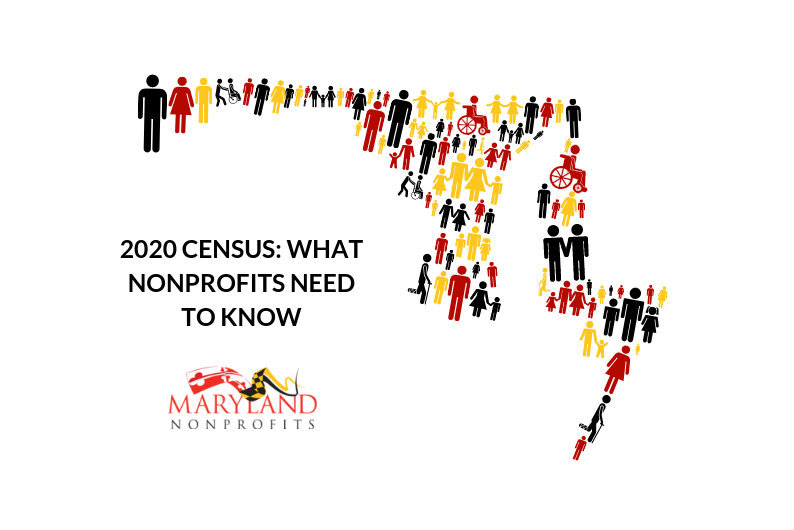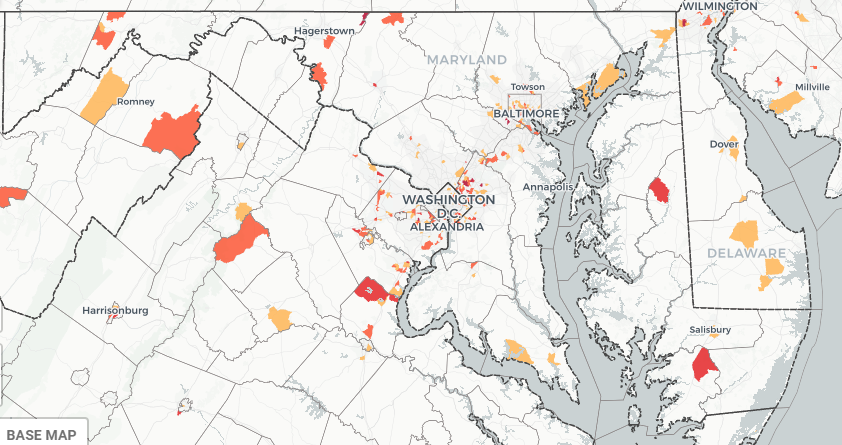WHY NONPROFIT INVOLVEMENT IS IMPORTANT
 Nonprofits play a critical role in helping ensure a complete count in Maryland. Many households would not participate in the Census if they did not get encouragement from a trusted source. Community-based organizations are highly trusted sources of information. Therefore your encouragement and assistance to people who need it will truly make a difference.
Nonprofits play a critical role in helping ensure a complete count in Maryland. Many households would not participate in the Census if they did not get encouragement from a trusted source. Community-based organizations are highly trusted sources of information. Therefore your encouragement and assistance to people who need it will truly make a difference.
Now that the Supreme Court has, for the time being, prevented the addition of the citizenship question, nonprofits can direct their attention to ensuring that all Marylanders are counted, with extra attention to reach traditionally undercounted communities.
MESSAGING
Some nonprofits are getting creative about their messaging, such as the National Association of Black Storytellers promoting “I Want to Be in That Number!” We are more universally going with “Everyone Counts, Be Counted.” Some important reasons that resonate across all demographic groups are the importance of critical funding for their communities, such as education and roads.
TIMELINE
Today – August 2020: Raise awareness among people you serve to participate in the Census and BE COUNTED.
April 1, 2020 is Census Day. The 2020 Census mailers will begin to go out in March of 2020.
April – August 2020: Get the word out, help people you serve to get counted.
Online & Paper Forms: For the first time, the Census will be an online survey for most households whose first communication about the Census will be a letter instructing them to take the survey online. About 20-25% of households will receive the paper survey as well as the letter. Postcards will be mailed to non-respondents, and in April 2020, all non-respondents will receive the letter and questionnaire.
$16B IN FUNDING IN MARYLAND RELIES ON THE CENSUS
About one-third of Maryland’s state budget comes from federal sources, and 55 large federal programs rely on Census data for their allocations. More than $16 billion in funding, the equivalent of $2700 per person in Maryland, is based on Census-derived data, including critical programs important to nonprofits and the communities we serve.
Beyond just the total population counted, Census demographic data (ages, income, housing or employment status, etc.) will be the basis for estimates of age, poverty or other determinants of federal funds for the coming decade.
Below are examples of how Census estimates will affect funding in Maryland:
-
- Lower population estimates based on a census undercount would reduce Maryland’s share of federal highway planning and construction grants – $599 million in FY 2016
- A census undercount of children, particularly poor children, would increase the likelihood of reduced Title I Education grants to Local Education Agencies (LEA’s) – $206 million in FY2016, and also the likelihood of reduced special education funding for the state and LEAs – $204 million in FY 2016
- An undercount in 2020 would increase the chances for less accurate local unemployment estimates, and could affect a locality’s eligibility for the waiver to continue SNAP (nutrition assistance) beyond the time limits for childless adults. Census data also helps determine poverty thresholds and guidelines for eligibility.
- Census-derived data is used to determine housing needs geographically, in turn, used to allocate Section 8 Housing Vouchers among Public Housing Agencies (PHA’s) – $550 million in FY 2016, as well determining eligibility for ‘project based’ Section 8 assistance – $223 million
- Undercounting families with young children in poverty would threaten the level of funding for Head Start and Early Head Start expansion providers – $95.8 million in FY 2016
- Undercounting low-income households could lead to under-estimates of their heating fuel use and a lower LIHEAP (Low Income Home Energy Assistance Program) grant to the state – $72 million in FY 2016
- Funding for Community Health Centers could be lost in areas where eligible families are undercounted during the Census – $59 million in FY 2016.
In addition to the above, Census-driven data has an effect on:
-
- Media Assistance Program ($5.5b)
- Medicare Part B ($1.6b)
- State Children’s Health Insurance Program ($234m)
- National School Lunch Program ($160m)
- Foster Care ($56m)
- Child Care and Development Fund ($53m)
While the actual 2020 Census count will be used directly in only a few programs across the next decade, data collected in 2020 will form the ‘baseline’ that is adjusted by numerous other federal population- or demographic- surveys during the 2020’s to determine funding levels or eligibility.
MARYLAND’S HARD TO COUNT POPULATIONS
Maryland’s last two Census had participation rates of 76%. The 2010 Census saw highest participation in Harford and Howard Counties (81% respectively), and lowest in Worcester (59%), Garrett (67%) and Baltimore City (68%). Counties that improved the most from 2000-2010 were Somerset (going from 61% to 69%) and Baltimore City going from 63% to 68%.
HTC 2020, a project of City University of New York, provides interactive maps of Hard to Count populations by Census tract. Populations are considered “hard to count” based on whether they respond to the questionnaire via the internet of mail-in, or the self-response portion of the census. So, the participation rate of 76% in Maryland means that the costly in-person follow up was required for 24% of households. A Census Tract below 73% is considered “hard to count.” According to HTC 2020:
Historically, the census has undercounted young children, people of color, rural residents, & low-income households at higher rates than other population groups. (See Race and Ethnicity in the 2020 Census [PDF].) Also, groups with low self-response rates in prior censuses or census tests include “linguistically isolated” households; frequent movers; foreign-born residents; households below the poverty line; large (i.e. overcrowded) households; low educational attainment households; & single-parent headed households. And people who distrust government authorities and/or have been or could be targets of law enforcement or heightened surveillance may be less likely to respond to the census.
Hard to Count Populations in the Region – click to see interactive map
CENSUS DATA IS CONFIDENTIAL BY LAW
Many people are fearful that the data they provide to the 2020 Census will be used against them by immigration or law enforcement organizations. However, using census data in this way is illegal. A full list from the Brennan Center for Justice on the federal laws that protect the confidentiality of census data can be found here – below is a summary of what those laws do.
- It is illegal for the Census Bureau to disclose census responses that would personally identify any respondent.
- It is illegal for anyone to see census responses except for employees of the Census Bureau, who are sworn to secrecy under threat of criminal punishment.
- It is illegal for the Census Bureau to disclose census responses to other government agencies.
- It is illegal for data collected for the census to be used for any nonstatistical purpose, such as immigration regulation or other law enforcement.
- It is illegal for the Census Bureau or any other federal agency to use census data to the detriment of the person to whom the information pertains.
HOW TO GET INVOLVED
See the National Council of Nonprofit’s outlines on the US Census here and tips for nonprofit engagement, as well as resources listed here:
- Convene and educate community leaders and other stakeholders, including the media, about the Census.
- Identify and partner with organizations and community stakeholders that are already connected to hard-to-count communities and have built strong relationships and trust.
- Work with state, county, tribal, and local government leaders to create and engage in Complete Count Committees (volunteer committees of government and community leaders from different sectors established to increase awareness about the census and promote participation).
- Use the Census Project toolkits to take action. Maryland’s Census Outreach Tool Kits with flyers available in English, Spanish, Korean, and Haitian Creole.
- For example, share this PDF from the 2020 Maryland Complete Count Committee, entitled Important, Easy, Safe
- The Census Bureau’s Guidelines for Partners: Supporting Self-Response in the 2020 Census
- Participate in Complete Count efforts in your jurisdiction.
-
-
-
-
- Maryland: The state-wide complete count committee has monthly meetings in rotating locations.
- Baltimore City
- Prince George’s County
-
-
-
-
- Census Bureau Fact Sheet on Group Quarters.
Updated August 23, 2019


